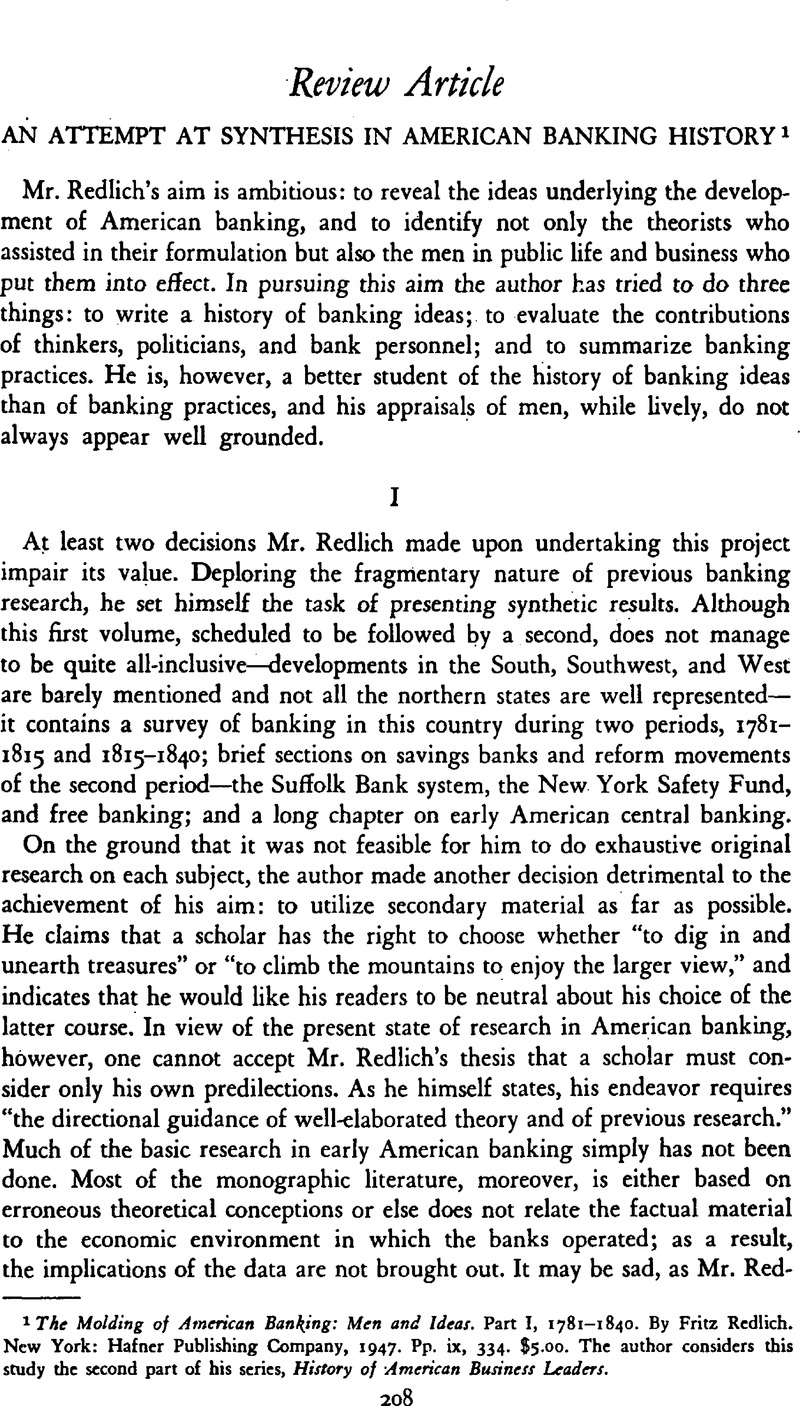No CrossRef data available.
Published online by Cambridge University Press: 03 February 2011

2 Mr. Redlich's designation of free banking as “a piece of reform legislation caused by a national calamity” (p. 196) does not seem quite accurate. He cites Helderman as his source, but the latter notes that the panic of 1837 was definitely secondary and “that the driving power lay in social and economic forces prior to the panic.”—Helderman, L. C., National and Stale Banks (Boston and New York: Houghton Mifflin Company, 1931), p. 20.Google Scholar The Michigan Free Banking Act was passed before the panic broke, and in New York the safety banking system was not discredited as a guarantor of bank debts until several years after free banks were opened.
Mr. Redlich remarks that bond security for note issues of Safety Fund banks was suggested in 1857 (p. 297, n. 93). The principle had actually been extended in 1848 to an authorized increase in the circulation of Safety Fund banks with capitals larger than $200,000.
3 Directors' minutes, November 17, 1806, Bank of North America Papers in the Historical Society of Pennsylvania; Pennsylvania Statutes, laws passed 1809–10, Act of March 19, 1810, chap. 65; Carey, Mathew, Desultory Reflection (2d ed.; Philadelphia, 1810), p. 13.Google Scholar Mr. Redlich cites this reference on p. 234, n. 60, which, incidentally, erroneously dates the sourcec as 1811; cf. the bibliography, p. 309.
4 Let me cite the case of James Wilson, one of the founders of the Bank of North America, whose familiarity with Sir James Steuart's writings is highly gratifying to Mr. Redlich. Mr. Redlich states that the men who stood at the cradle of American banking made history by choosing “banking on mercantile credit” rather than “banking on real and personal estates.” Yet at least twice during 1784 Wilson tried to borrow sums as large as $20,000 from the Bank of North America for his land schemes (Thomas Willing to James Wilson, January 24 and June 24, 1784, in Bank of North America Papers). As early as February 18, 1786, directors’ minutes of the bank indicate renewal for not over six months of various notes of Wilson and Mark Bird, a member of his wife's family, with whom he purchased the Somerset Mills on the Delaware (Dictionary of American Biography, XX, 329). A proviso stated that at least $30,000 be paid off within the six months; the full amount the partners had borrowed may be conjectured. N. S. B. Gras says of Massachusetts Bank discounts in 1785, “.… if the ruling was followed, they were for only thirty days.”—The Massachusetts First National Bank of Boston, 1784–1934 (Cambridge: Harvard University Press, 1937), p. 45.Google Scholar Mr. Redlich and earlier students of the beginnings of American banking have been taken in by rules and have not investigated whether they were followed.
5 Thomas Willing to William Bingham, October 20, 1783, in Balch Papers, The Historical Society of Pennsylvania.
6 Various centennial studies may be cited: Ashmead, H. G., History of the Delaware County National Bank (Chester, Pennsylvania, 1914)Google Scholar; The Hagerstown Bank at Hagerstown, Maryland. Annals of One Hundred Years, 1807–1907 (Knickerbocker Press, 1910)Google Scholar; The Jefferson County National Bank, Watertown, New York, Centennial Historical Souvenir, 1816–1916; Kleinhaus, P. L., Down Through the Years, The Story of the National State Bank, of Elizabeth, New Jersey, 1812–1937 (Elizabeth, New Jersey, 1937).Google Scholar
7 Pennsylvania Senate, Journal, 1811/12, pp. 76–79.
8 Cf. Smith, Walter B. and Cole, Arthur H., Fluctuations in American Business (Cambridge: Harvard University Press, 1935), p. 28.Google Scholar Mr. Smith presents semiannual data on specie holdings of three Boston banks, 1810–20. Sec also Bullock, C. J.Williams, J. H. and Tucker, R. S., ‘The Balance of Trade of the United States,” Review of Economic Statistics, I (1919), 215–17.CrossRefGoogle Scholar
8 The Philadelphia Bank made a loan of $50,000 to the Bank of Georgia in 1821 and one of $150,000 to the Bank of New Orleans in 1831.—Cook, Joel, The Philadelphia National Bank.; a Century's Record, 1803–1903, by a Stockholder (Philadelphia: W. H. Fell, 1903), p. 79.Google Scholar In 1821, in answer to a House resolution requiring the Farmers’ and Mechanics’ Bank of Philadelphia to state the amount loaned to farmers, the bank referred to a loan made to the Bank of Centre County.—Pennsylvania House of Representatives, Journal, 1820/21, pp. 301–2. See also Annual Report of New York. State Bank Commissioners, 1842, pp. 19–20.Google Scholar
10 Annual Report of New York State Bank Commissioners, 1837, p. 14.Google Scholar
11 Annual Report of New York State Bank Commissioners, 1831, p. 5.Google Scholar
12 Bray Hammond has offered a hint for a variant analysis.—See this Journal, VII (May 1947), 20. Messrs. Redlich and Hammond, incidentally, differ in their views of Biddle's responsibility for the depression of 1833–34 and the meaning of Jackson's statement in his first annual message that the Bank had failed to establish “a uniform and sound currency.”—See this Journal, VII (May 1947), 11 and 5, and Mr. Redlich's book, pp. 154, and 287 n. 37. A quotation from Kendall, cited by Mr. Redlich (p. 172), seems to support Mr. Hammond's interpretation of the latter point.